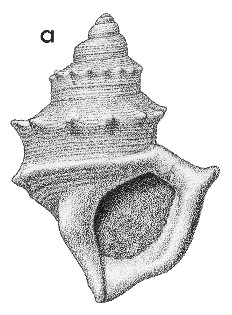
Revised descriptions of New Zealand Cenozoic Mollusca from Beu and Maxwell (1990)

 | Revised descriptions of New Zealand Cenozoic Mollusca from Beu and Maxwell (1990) | 
|
  (Pl. 15a): GS9805, F44/f9501, Coal Brook Station, Wendon Valley, Southland, Duntroonian (GNS) |
Beu & Maxwell (1990): Chapter 10; p. 158; pl. 15.a.
Synonymy: Struthiolaria (Struthiolaria) cf. "prior Finlay 1926b", p. 228
Classification: Struthiolariidae
Description: The status of S. prior is uncertain, but it seems probable that it is not worth separating from S. calcar (= S. subspinosa) (see pl. 20 g, h). Finlay (1926b, p. 228) separated it from S. calcar on the basis of its lower-placed shoulder angulation, its finer spiral sculpture and its more coarsely nodulose peribasal angulation, but these alleged differences do not seem to be constant.
Comparison: Although Struthiolaria is one of the most distinctive and characteristic gastropod genera in the New Zealand mid and late Cenozoic, its antecedents are unknown. The problem is exacerbated by the lack of any record of the family until recently from much of the New Zealand region during the Late Eocene and Early Oligocene (Kaiatan-Whaingaroan). However, specimens closely resembling S. calcar are now known from Runangan beds in southern Northland. Monalaria, which was widespread during the Bortonian (see Pl. 6a, b), seems to be an unlikely candidate for an ancestor to Struthiolaria, if only because of its very different sculptural plan. The sculpture of early species of Struthiolaria such as S. calcar is instead very similar to that of the Early Paleocene Conchothyra australis (Pl. 12g, h), and despite important differences in columellar and outer-lip characters between these taxa, it seems likely that Struthiolaria was derived from Conchothyra or a related taxon, possibly outside the New Zealand region. The new specimens from Northland merely extend the date of derivation from Conchothyra back to at least Late Eocene time.
Distribution: Struthiolaria prior was based on two specimens from the Chatton Formation at Waikaia, Southland (Duntroonian), a locality apparently no longer accessible to collectors; the specimen figured here is from approximately coeval beds about 15 km to the south-east. It is figured here because of its interest as one of the earliest records of the genus, although similar specimens, assigned to S. calcar, are now known from Runangan beds near Kaipara Harbour, southern Northland.
Cite this publication as: "A.G. Beu and J.I. Raine (2009). Revised
descriptions of New Zealand Cenozoic Mollusca from Beu and Maxwell (1990). GNS
Science miscellaneous series no. 27."
© GNS Science, 2009
ISBN
978-0-478-19705-1
ISSN 1177-2441
(Included with a PDF facsimile file
copy of New Zealand Geological Survey Paleontological Bulletin 58 in CD version
from: Publications Officer, GNS Science, P.O. Box 30368 Lower Hutt, New
Zealand)